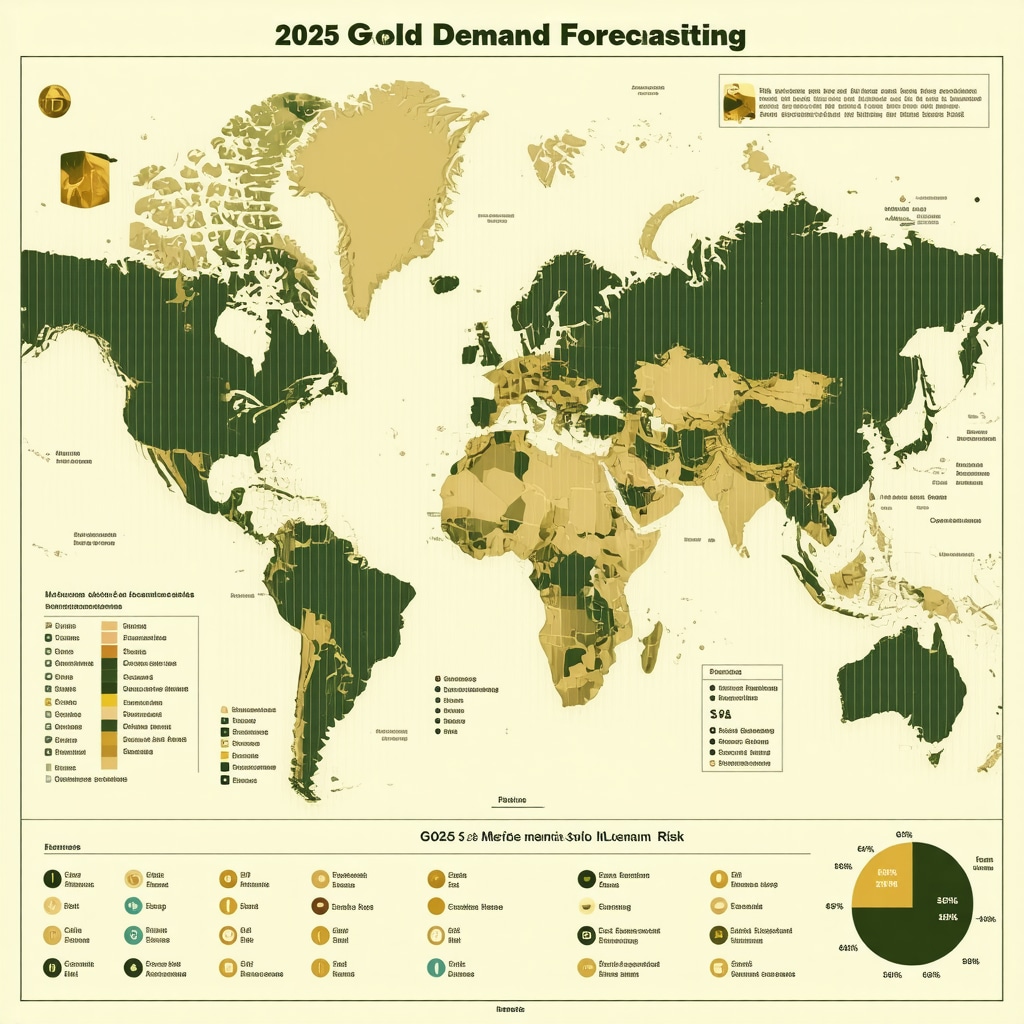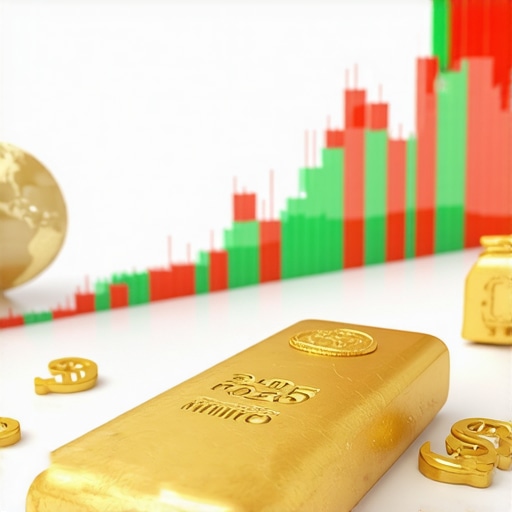Understanding the Macro Drivers Behind Gold Demand in 2025
In the complex ecosystem of global finance, gold remains a pivotal asset underpinning portfolio diversification and risk mitigation strategies. As we advance through 2025, the dynamics shaping gold demand are increasingly influenced by multifaceted economic, geopolitical, and technological factors. Investors seeking to align their strategies with evolving market realities must dissect these underlying forces with precision and foresight.
Central Bank Gold Purchases: A Critical Force Shaping Market Liquidity and Prices
Central banks continue to play a dominant role in the gold market, actively adjusting their reserves to hedge against currency volatility and inflationary pressures. Their strategic acquisitions create ripple effects across global supply-demand balances, impacting gold prices and investor sentiment alike. Detailed analysis of central bank buying trends, as explored in this comprehensive study, reveals how institutional demand can amplify price momentum and signal macroeconomic confidence shifts.
Technological Innovations and Evolving Gold Applications
Beyond traditional uses, gold’s unique properties are increasingly harnessed in cutting-edge sectors such as electronics, renewable energy, and biomedicine. This expansion diversifies demand sources, introducing new growth vectors that are less correlated with conventional investment and jewelry markets. Investors must incorporate these technological demand drivers into their valuation models to accurately anticipate long-term market trends.
How Can Investors Accurately Forecast Gold Demand Amidst Economic Uncertainties?
Forecasting gold demand involves synthesizing data from diverse sectors: jewelry consumption, industrial applications, investment flows, and central bank activity. Utilizing advanced demand-supply analytics, such as those detailed in this expert resource, investors can construct nuanced predictive frameworks. These incorporate macroeconomic indicators, geopolitical risk assessments, and market sentiment analytics, enabling more resilient investment decisions.
Integrating Gold Demand Analysis into Your Investment Strategy
For investors aiming to capitalize on gold’s multifaceted demand trends, integrating granular market insights with sophisticated portfolio management techniques is paramount. Strategic allocation across physical gold, ETFs, and mining equities can optimize risk-adjusted returns while safeguarding against inflationary erosion. For an in-depth guide on structuring gold investments in 2025, consider exploring this detailed roadmap.
Call to Action: Engage with Specialized Gold Investment Analyses
Investors and financial professionals are encouraged to deepen their expertise by accessing advanced analyses and contributing to expert forums focused on gold market dynamics. Staying informed through authoritative sources and peer dialogue enhances decision-making efficacy in this volatile yet rewarding asset class.
For further academic insights on gold as a strategic asset, consult the World Gold Council’s latest whitepapers and market reports at https://www.gold.org/research.
Decoding Gold Demand Fluctuations: Beyond Traditional Metrics
As gold demand evolves in 2025, investors must move beyond basic indicators such as jewelry sales and central bank reserves. Incorporating real-time data analytics, geopolitical event monitoring, and sector-specific technological adoption rates offers a sophisticated lens for understanding nuanced demand shifts. This multi-dimensional approach enables market participants to anticipate turning points and capitalize on emerging trends with greater precision.
Linking Macroeconomic Indicators to Gold Demand Dynamics
Gold’s historical role as a safe haven asset intensifies its sensitivity to macroeconomic variables like inflation rates, currency strength, and interest rate policies. However, the interplay between these factors and gold demand is complex and often nonlinear. For instance, rising interest rates might suppress investment demand but simultaneously trigger increased central bank purchases, as highlighted in expert analyses. Investors who integrate these countervailing forces into their models achieve a more robust forecast capability.
What Are the Emerging Analytical Tools Shaping Gold Demand Forecasting in 2025?
Cutting-edge analytical tools leveraging artificial intelligence and machine learning are transforming gold demand forecasting. These technologies assimilate vast datasets encompassing market sentiment, geopolitical news feeds, supply chain disruptions, and consumer behavior patterns. Platforms integrating such tools offer investors actionable insights, enabling dynamic portfolio adjustments in response to rapidly evolving conditions. Staying abreast of these innovations is critical for outperforming the market in 2025 and beyond.
Leading financial institutions, including the World Gold Council, emphasize the importance of these advanced methodologies in their 2025 market outlook reports (World Gold Council Research), underscoring the rising complexity of gold market dynamics.
Strategic Portfolio Construction: Balancing Physical Gold and Financial Instruments
Building a resilient gold portfolio today demands a strategic blend of physical assets and financial products such as ETFs, futures, and mining stocks. Each asset class reacts differently to supply-demand shifts and macroeconomic stimuli, providing diversification benefits when combined thoughtfully. For investors seeking detailed guidance on asset allocation tailored to 2025 market realities, the comprehensive portfolio construction guide offers invaluable insights.
This nuanced approach mitigates volatility risks and leverages distinct demand drivers across the gold investment spectrum, optimizing long-term returns.
Integrating Real-Time Market Intelligence for Proactive Investment Decisions
In an environment where geopolitical tensions and economic policies can shift rapidly, real-time market intelligence is indispensable. Investors benefit from platforms providing instant updates on central bank activities, mining output reports, and tech sector demand changes. These data streams allow for agile repositioning ahead of broad market moves, enhancing portfolio resilience.
By adopting such proactive strategies, investors can better navigate the complexities of gold demand and price movements in 2025.
Engage with the Gold Investment Community for Deeper Insights
Active participation in expert forums and discussion groups focused on gold market trends enriches investor knowledge and sharpens analytical skills. Sharing experiences and strategies with peers fosters a collaborative environment conducive to uncovering novel investment opportunities and risk mitigation tactics.
We invite you to share your perspectives on evolving gold demand trends in the comments below and explore more expert content to refine your investment approach.
Harnessing Artificial Intelligence to Decode Complex Gold Demand Patterns
As 2025 unfolds, the integration of artificial intelligence (AI) into gold demand analytics transcends traditional forecasting methods. AI algorithms, particularly those employing deep learning and natural language processing, are uniquely capable of parsing multifactorial datasets—from central bank reserve adjustments and geopolitical news to social media sentiment and industrial gold consumption trends. These models dynamically adapt to emerging patterns, uncovering latent correlations that human analysis might overlook.
For instance, AI-driven sentiment analysis can quantify investor confidence shifts in real time, correlating them with gold price volatility. Similarly, machine learning models trained on historical demand-supply data can simulate scenario-based forecasts that incorporate macroeconomic shocks or supply chain disruptions. Such granular insights empower portfolio managers to preemptively adjust asset allocations, thereby optimizing risk-adjusted returns amidst uncertainty.
How Does Behavioral Economics Enhance Gold Demand Forecasting Models?
Incorporating behavioral economics principles into demand forecasting provides nuanced perspectives on investor psychology and decision-making heuristics that influence gold markets. Cognitive biases such as loss aversion, herd behavior, and anchoring effects can precipitate demand surges or contractions independent of fundamental economic indicators. By embedding these behavioral variables into quantitative models, analysts can better anticipate non-linear demand fluctuations triggered by market sentiment shifts or geopolitical events.
For example, during periods of heightened geopolitical tension, investors may disproportionately flock to gold as a safe haven, amplifying demand beyond what standard models predict. Recognizing these patterns enables more robust scenario planning. The World Gold Council’s research highlights how melding behavioral insights with econometric data enhances forecasting precision (World Gold Council Behavioral Finance Studies).
Decentralized Finance (DeFi) and Blockchain: Emerging Frontiers Influencing Gold Investment Dynamics
Decentralized finance platforms and blockchain technology are progressively reshaping gold investment landscapes by facilitating tokenized gold assets and enhancing liquidity. Tokenization allows fractional ownership of physical gold, lowering entry barriers and introducing new investor demographics to the market. Smart contracts automate settlement processes, reducing counterparty risk and increasing transactional transparency.
This technological evolution not only broadens demand sources but also introduces volatility dynamics distinct from traditional gold markets. Understanding the interplay between DeFi gold tokens and conventional investment vehicles is crucial for sophisticated portfolio construction. Investors must evaluate the regulatory environment, technological adoption rates, and interoperability challenges to effectively integrate these innovations.
Advanced Risk Management Strategies Amidst Gold Demand Volatility
Given the multifaceted drivers of gold demand volatility—from macroeconomic shifts to technological disruptions—implementing advanced risk management frameworks is indispensable. Techniques such as dynamic hedging, scenario stress testing, and real-time risk analytics enable investors to navigate uncertainties with agility.
Moreover, integrating cross-asset correlation analyses helps identify contagion risks between gold and other asset classes during market turbulence. Such comprehensive approaches mitigate drawdowns and preserve capital in volatile cycles, reinforcing gold’s strategic role as a portfolio stabilizer.
Call to Action: Elevate Your Gold Market Expertise with Cutting-Edge Research
To harness these sophisticated analytical techniques and stay ahead in gold investment strategies, we invite you to explore specialized resources and participate in expert-led seminars. Deepening your understanding through continuous learning and active engagement with industry thought leaders will equip you to decode complex market signals and capitalize on emerging opportunities.
Delve deeper into the intersection of AI, behavioral economics, and gold markets by visiting the World Gold Council’s dedicated research portal: https://www.gold.org/research.
Unraveling the Impact of Geopolitical Volatility on Gold Demand Elasticity
Geopolitical instability remains a paramount catalyst influencing gold demand elasticity, often precipitating rapid shifts in investor behavior that defy traditional predictive models. The nuanced interdependence between regional conflicts, trade disputes, and macroeconomic policy oscillations creates a complex ecosystem where gold demand responds non-linearly. For instance, nuanced geopolitical flashpoints in Asia and Eastern Europe have historically triggered asymmetric demand surges, underscoring the necessity for investors to employ granular geopolitical risk indices alongside conventional economic indicators.
Leveraging Quantitative Behavioral Models to Decode Investor Sentiment Swings
Advanced quantitative behavioral models integrating sentiment analysis derived from alternative data streams—such as social media metrics, news analytics, and market microstructure data—are proving indispensable in capturing transient investor mood shifts that traditional fundamental analysis may overlook. By quantifying sentiment-driven anomalies, these models enhance the detection of emergent demand patterns and potential price inflection points, thereby refining tactical asset allocation strategies within gold portfolios.
How Can Machine Learning Algorithms be Tailored to Capture Non-Linear Demand Drivers in the Gold Market?
Machine learning (ML) algorithms, particularly ensemble methods and neural networks, can be meticulously tailored to capture the intricate non-linear interactions among diverse demand drivers in gold markets. Feature engineering that incorporates macroeconomic variables, geopolitical event embeddings, and real-time transactional data enables ML models to recognize complex patterns and forecast demand fluctuations with higher fidelity. Techniques such as Long Short-Term Memory (LSTM) networks are especially effective in modeling temporal dependencies and sequential market behaviors. Continuous model retraining with high-frequency data ensures adaptability to market regime shifts, a critical advantage in volatile environments.
Integrating ESG Considerations into Gold Demand Assessments
The rising prominence of Environmental, Social, and Governance (ESG) criteria is reshaping gold demand paradigms, particularly as investor preferences increasingly favor sustainably sourced and ethically mined gold. This shift compels market participants to incorporate ESG metrics into demand forecasting models, recognizing that compliance and certification standards influence both supply chain integrity and consumer demand dynamics. Consequently, the proliferation of ESG-compliant gold products is creating differentiated market segments with distinct demand trajectories.

Exploring the Role of Central Bank Digital Currencies (CBDCs) in Gold Investment Flows
The advent of Central Bank Digital Currencies introduces a transformative dimension to gold investment flows by potentially altering liquidity channels and cross-border transactional efficiencies. CBDC frameworks may facilitate streamlined gold-backed digital asset transactions, enhancing market accessibility and transparency. However, they also pose regulatory and operational challenges that could impact central banks’ gold reserve management strategies and, by extension, global demand patterns.
Harnessing Multi-Asset Correlation Analytics for Gold Portfolio Optimization
Employing sophisticated multi-asset correlation analytics enables investors to dissect dynamic inter-asset relationships under various market conditions, thereby optimizing gold allocations within diversified portfolios. By analyzing co-movements between gold, equities, fixed income, and alternative assets through copula models and dynamic conditional correlation frameworks, investors can identify hedging efficacies and diversification benefits that fluctuate over economic cycles.
Authoritative Insight: World Gold Council’s Cutting-Edge Research on Gold Market Microstructure
For a deep dive into the evolving gold market microstructure and its implications on demand and pricing, the World Gold Council’s latest research provides exhaustive empirical analyses and advanced modeling techniques (World Gold Council Research Portal). This resource is indispensable for professionals seeking to incorporate state-of-the-art methodologies into their analytical repertoire.
Call to Action: Elevate Your Gold Investment Acumen with Expert Analytical Frameworks
Engage with these advanced frameworks by accessing specialized datasets, participating in expert symposiums, and adopting machine learning tools tailored for gold market analysis. Harnessing these insights empowers you to anticipate intricate demand shifts and strategically position your portfolio for resilience and alpha generation amid 2025’s complex market landscape.
Expert Insights & Advanced Considerations
Central Bank Purchasing Patterns Remain a Leading Demand Driver
Central banks’ strategic gold acquisitions continue to shape liquidity and price dynamics globally. Understanding the timing, scale, and geopolitical motivations behind these purchases is critical for anticipating market movements. For a detailed exploration of these mechanisms, investors should consult analyses like how central bank gold purchases drive demand and prices worldwide.
Technological Integration Expands Gold’s Industrial Demand
Gold’s application in sectors such as electronics, renewable energy, and biomedical devices introduces less cyclical and more innovation-driven demand streams. Integrating technology sector forecasts with traditional demand models provides a more holistic perspective on gold’s evolving market role.
Behavioral Economics and AI Enhance Forecasting Precision
Incorporating investor psychology through behavioral economics, alongside machine learning algorithms designed to detect non-linear demand patterns, significantly improves forecasting accuracy. These advanced methodologies empower investors to respond proactively to market sentiment shifts and geopolitical shocks.
Decentralized Finance and Blockchain Technologies Reshape Investment Access
The emergence of tokenized gold assets via DeFi platforms lowers barriers and diversifies investor profiles, altering liquidity and volatility characteristics. Evaluating these technological innovations alongside traditional physical and financial gold instruments is essential for comprehensive portfolio construction.
ESG Criteria Drive Demand Segmentation and Supply Chain Transparency
Environmental, Social, and Governance considerations increasingly influence gold sourcing and investor preferences. Forecasting models must now integrate ESG metrics to accurately assess demand elasticity and market segmentation, reflecting the growing emphasis on sustainable investing.
Curated Expert Resources
- World Gold Council Research Portal: Offers exhaustive empirical research and advanced market modeling critical for understanding gold’s microstructure and demand drivers (https://www.gold.org/research).
- Buying Gold Now – Gold Demand and Supply Insights: Provides detailed analyses on supply-demand fundamentals, central bank activities, and market trends (gold supply and demand explained).
- Gold ETF and Mining Stock Portfolio Guides: Comprehensive resources for balancing physical and financial gold investments to optimize risk-adjusted returns (how to create a balanced portfolio with gold ETFs and stocks).
- Advanced Machine Learning Applications in Gold Markets: Key readings on tailoring ML algorithms for capturing complex demand drivers and sentiment analytics (gold demand trends 2025 insights).
- ESG and Sustainable Gold Investment Frameworks: Resources focusing on integrating ESG criteria into gold demand and supply assessments to align with emerging investor priorities (understanding gold supply and demand).
Final Expert Perspective
In 2025, gold demand transcends classical drivers, intertwining central bank strategies, technological innovation, behavioral finance, and sustainability considerations. Mastery of these complex, interconnected factors distinguishes the sophisticated investor poised to capitalize on gold’s multifaceted market dynamics. By leveraging advanced analytical tools and authoritative resources such as the 2025 gold price forecast and key market factors, professionals can craft resilient strategies tailored to evolving economic realities. Engage with this evolving discourse by contributing your insights and exploring related expert analyses to refine your gold investment acumen further.









